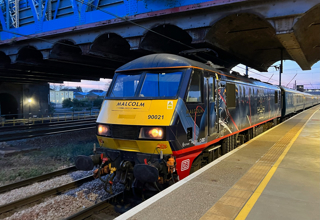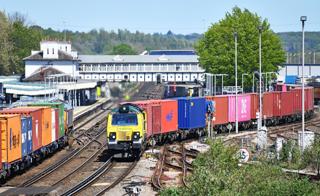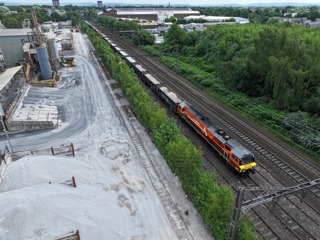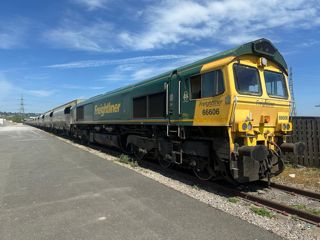Ahoy there, Treasure Island!
With acknowledgement to Tony Mercado, at the time seconded to the Department for Transport as its Technical Director, who coined the term to describe how Britain was conspiring to achieve uniquely high project costs while delivering indifferent quality.
That was in the first decade of this century, when even the simplest of benchmarking showed that costs for basic work such as track or signalling renewal were around twice that of the highest cost economies in Europe.
Things could only get better. Sadly, they got worse! The ‘Railway Credit Card’ mindset that set in after Hatfield fertilised the magic money tree, whose bitter fruit we are now harvesting. There are great people in the new generation of engineers and project managers, but what an uphill struggle lies before them to reverse the bad practices of the past two decades.
Electrification is an excellent current example. If the projects that are under way now can show delivery near to benchmark good practice figures - under £2 million per single track kilometre (stkm) - then the prospect of unlocking a long-term programme is excitingly real.
We saw the significant recovery of sensible engineering decision-making on the last section of the Great Western Electrification Programme, from the nadir of appalling practice driving the reported £4m/stkm previously, as well as similar improvements in elements of the North West work.
In Scotland, a robust approach to all aspects (from scope to specification, then practical design and efficient construction) by client, regulator, asset managers and the supply chain together has also delivered a better result - not good enough yet, but a platform from which continuous improvement can bridge the gap to true affordability. The answers are out there, we just need to want them enough.
We have to recognise that we are sailing against at least four well-established adverse winds, as well as a new fifth one which may or may not be shorter-lasting.
First, the attitude among some (often senior) managers that the railway justifies limitless public finance, because “we’re worth it” or even because of decarbonisation. There are alternatives, and only by being demonstratively cost-effective can we argue our rightful place in the transport system.
The key word is cost-effective. Cheap but inadequate work, with no designs or records, is not what this is about. For example, too much track renewal work has been in the ‘good enough’ category, which is code for ‘it’s good enough to avoid a speed restriction’.
What is being paid for is a major investment that should last decades and be almost maintenance-free for a number of years - so it’s not only too expensive, it’s not effective either. The same people in the client organisation wouldn’t be happy using that approach to a new roof on their house, paid for with their money.
Second, the industry has progressively added more and more costly and time-consuming processes as sticking plaster for failing to invest in genuinely training its people - a continuing legacy of the casualisation of labour post-privatisation.
Nowhere is this more apparent than in the gap between the remaining seasoned supervisors and managers and those who should be following them. Of course, the senior managers can be (and have been) brought in, sometimes beneficially, but focusing on this is like polishing the leaves and admiring the flowers rather than feeding the roots that sustain the plant.
Third, the civil engineering industry is still exhibiting the consequences of the Carillion crash.
At the same time as it became fashionable for clients to off-load project risk, design liability and self-assurance to their contractors, few have the balance sheet to accept these accountabilities. Insurance is expensive, so the only way a contractor can react is to price in the risk - a classic case of client naivety.
The first duty of a contractor is to its Board and shareholders, so this is hardly unexpected. And it is compounded if the client follows the equally fashionable avenue of ‘alliancing’ before it has decided what it actually wants.
To use the domestic house analogy once again: you really wouldn’t contract with a builder based on promises of working collaboratively before deciding what sort of house you wanted built - and then ask nicely if you could have a competitive price. Naivety squared.
Fourth is the serious commercial situation in which many of our traditional designers find themselves.
Since abolition a long time ago of scale fees, there has been a steady depressing race to the bottom through clients parcelling work out to the lowest tenderer.
Few consultants have been able to afford proper training schemes, and many are reliant on a few ageing seasoned engineers (the ones put in front of clients to win work) and a bunch of computer jockeys who feed numbers into apparently sophisticated programs. Those numbers will be very risk-averse, given the liabilities that the client is seeking to offload to the designers and the attitude of their owners and insurers.
This is also compounded by the fashion for clients to let design and construct packages to contractors who (of course) choose the consultant who will be cheapest and least demanding. The consultant’s duty is to the contractor, not the client, and anyone who believes otherwise is not living in the real world.
Then there is the more recent current pressure of cost inflation from competing opportunities for the civil and building supply chain, from major projects such as highways or HS2 through to the explosion in domestic building works funded by lockdown cash.
It may be that the current shortages in building materials will be short-lived. But with clients reporting real upwards cost pressures from the supply industry overheating, compounded by the loss of some European skilled staff, the next few years look challenging.
Initiatives such as Project SPEED are rightly welcomed. They are essential and need every support to be driven through. However, at the same time we must recognise that they will counter some of the current upwards pressures (good), but not be anything like sufficient.
This is a world where we should aim for the cost of projects to be halved - or more. A reorganised industry has to deliver projects that sustain and develop its infrastructure at a price that the country recognises as value for money. And reorganisation, real or just anticipated, has a long history of distracting managers from the work in hand.
Fundamental improvement can only come from the client - how it discharges its sponsorship responsibilities, and how it project manages delivery.
However much a client outsources work, or keeps it in-house, the two vital competencies it needs to retain are the ability to know what a sound solution would need to be to achieve any desired outcome, and to know the ‘should be’ cost of the work involved.
Then there is a third, which is to be able to assure the end result. Leaving it to ‘self-assurance’ by the designer/contractor is to outsource responsibility, however wonderful and aligned any particular contracting partner might seek to be. This is rather more than gathering paperwork with nicely scribed signatures.
Benchmarking can be a powerful tool in establishing ‘should be’ cost and time. But benchmarking between projects in the same environment is a misleading nonsense - comparing sick animals with each other, not with healthy ones, proving that one is averagely sick and that’s OK?
There is some scope for looking across sectors, such as into highways and utilities projects, and the applicability of identified better practice should be straightforward in similar legal and regulatory environments. But this only takes things so far.
Benchmarking with European railways and infrastructure industries is more challenging because the environments will be different. But it is potentially a most rewarding activity, especially when gradual incremental improvement is simply not enough. The art and science is to recognise the differences and draw out the similarities, and most of all to see better practice for what it is.
Strangely, the laws of physics are similar, and any suggestion that others have a fundamentally worse safety culture is black propaganda. Too often, more effort has been expended in either emphasising differences or pleading special mitigation.
A rule of thumb is that if there appears to be a 10% or 20% difference, then such arguments are possible… but not 50%+. So, track renewal or electrification installation costing over twice as much as in notoriously low-cost countries such as Germany and Switzerland shows something is fundamentally adrift.
Let’s consider what we learn from raising our eyes beyond little Britain - starting from the ground up and ending in the Boardroom.
Firstly, the raw cost of labour and materials is not greatly different, and the legal framework of regulation as well as personal professional liability can be more (not less) challenging in other countries. But after that, we start to diverge.
Railway on-track plant can be more expensive, given some uniquely British requirements and interpretation of legislation - especially around such detailed areas as hydraulic electric connectors.
But the overall impact is often overstated. The size of the British market and steady modularisation of equipment design over the past two decades has significantly overcome this factor. Individual component supply chains are international, as is off-track plant manufacture.
The first major divergence comes in railway construction competence. Ask to see the certification of any person on a railway site and expect a sheaf of personal safety stuff (albeit electronically saved), either on track safety rules or small machine operations - certainly necessary, except probably erring too much to the tick box mentality of corporate liability assurance.
However, there may well be next to nothing on competence to undertake the physical work effectively to the required quality. This is important. Benchmarked practice seen across the Channel is of a workforce that is salaried (whoever it works for), full-time, and properly trained in both the tasks to be carried out and (vitally) each individual’s role in the overall work process. Expect an atmosphere of calm ordered teamwork with little need for frequent shouted instruction.
Behind this will be artisan technical training (not just classroom multiple choice gloss), so that each member of the team understands the underpinning reason for what they are doing and the importance of doing it to standard. They will be technically certified by experienced and accountable supervisors.
Our military manages this, and quite a few railway managers are reservists, so understanding what needs to change shouldn’t be too difficult.
When challenged that all this costs money, the answer is that people doing things with personal pride, safely and to the right quality first time, is a far better way to achieve time cost and quality than an army of paper warriors - and the level of real-time supervision and assurance needed is minimal.
It is this approach which enables our neighbours to use around a third of the number of people to carry out routine infrastructure tasks such as switches and crossings renewal.
The supply industry rightly points to the need for a steady workbank, but this risks a classic ‘chicken and egg’ discussion - the workbank appears when the cost and delivery is successful.
The smaller, more specialist, contractors who can add real value to the way we do work are often the most committed to skills development, because it is part of the superior product they seek to sell.
It is these who need a reasonable belief that work will come, because they deliver well and won’t be crowded out by a cheap, low-skill competitor offering short-term price advantage at tender and little commitment to quality delivery later.
A bold client not measuring its project managers by short-term criteria alone makes the difference. There are some good examples in small-scale buildings and stations works around the country, so it can be done.
One bright spot in the past decades has been the improvement in personal safety of project work, which is rightly lauded. Much of this has been through cultural challenge on the ground.
However, given the importance of working separated from trains, the British approach to possessions of the line has tried to improve through layering additional process and ‘assurance’ sticking plaster, rather than stepping back and fundamentally reviewing just what we are asking people to do in hundreds of locations every week.
Any human factor analysis of British procedures and rules around taking, managing and giving up track possessions would conclude that they are so complex and multi-staged as to be virtually impossible to follow. Attempting to ensure safety by adding yet more process, in response to the inevitable failures which occur precisely through such complexity, is the clearest definition of insanity.
If most of the developed world, with similar expectations of the value of human life, expects to be starting work within ten minutes of the last train passing - using a short sequence of actions (not the 16+ of the British way) repeated, trained and rigidly audited - then we have to ask if we are the only dancer at the party in step with the music.
While the starting point of re-thinking the way that possessions are undertaken should be safety, the prize is equally productivity and cost-effectiveness - they are entirely complementary. Far more cost-effective work can hardly be expected until the way possessions are managed is dragged into the 21st century.
Behind this approach lies the big opportunity of standardisation. Standard specifications, solutions, tasks, project plans and possession activities are the gift that keeps on giving.
The work team achieves better and faster results from becoming expert at doing the same (or nearly the same) repeated activity. The work planning is simplified with off-the-shelf method statements, and fewer special non-standard drawings and details. Ordering of materials and construction equipment has less cause for error.
At its simplest, this is enforcing manufacturing production line discipline into an archaic infrastructure world. Unsurprisingly, when people are doing tasks that they understand and are properly trained for, while understanding from minute to minute what’s happening around them, safety risk is reduced.
The next efficiency gain is greatly reducing the industry that has grown up around bespoke work - the one-off method statements, the unique work content briefing, and the layers of assurance that any of this has been calculated correctly, let alone communicated and understood.
The control on errors in planning today is yet more assurance, and we need to reverse this culture. The cost avoided through not employing armies of process managers is really significant, but still pales compared with the even greater benefit in everyone doing what they understand well, and safely.
Put simply: everyone - business sponsors, engineers, project managers (including by DfT and the Office of Rail and Road) - needs to embrace the approach that most work can be specified from a small suite of ‘pre-assured’ standard jobs which deliverers (from planner to operative) repeat in rolling programmes week after week.
To be guarded against is the seductive whisper that “we could save a bit here if only we could adopt a non-standard approach”. This may sometimes be true, but it needs robustly challenging against the savings from the bigger picture. If it is a genuinely special case, then fine. Otherwise, if it is a better way, then change the standard process for everyone.
Likewise, standardisation of work does not mean turning our backs on innovation. Conversely, it makes it easier. As opportunities arise, they can be trialled once and then systematically adopted, rather than rejected because “we do things differently here”.
Another cultural shift is the assumption that designers, estimators and allied trades will lose out from not working each scheme from first principles. At one level this is true, but investment work is meant to be for the benefit of passengers and freight users… and funders,
Remember: the prize in the future is funding of the projects that the railway needs - an assured rolling programme - not maximising jam today and pricing this industry out of its future.
Standard specifications are not the same as blindly listing generic standards. Professional engineering is about selecting from standard approaches and details what is genuinely appropriate for any project, and explaining cogently to business managers and sponsors the scope that has genuine impact on cost and alternatives which, in that situation, would be almost as good at a significantly reduced cost. Simply doing whatever the client first asks for is simply unprofessional.
Continuing up the organisational ladder, at the heart of the issue is the major project culture that has grown since the mid-1990s of multi-layered organisations delegating and outsourcing technical and commercial risks that only the client can manage.
The previous professional understanding that 50% probability meant that half the work should come in under budget and half over, and over time balance out, was replaced by the mantra of zero acceptable risk of overrun of individual work items - leading to compounded layers of contingency.
Whenever there was a project failure in the ensuing years, the answer was that there needed to be yet more contingency (of both money and time), additional layers of procedure and assurance… and more project managers to oversee these.
Repeatedly adding complexity and cost, hiring ever more project managers and outsourcing the vital decisions on actual design and construction work, sounds a lot like the very definition of insanity.
You might think railway professionals would hold firm and push back, but it seemed that too many - especially in senior positions - were more than happy to accept the extra budget authority (and with it the personal pay rises) and lower risk that came from this approach.
The practice of planning and estimating projects on a worst eventuality basis rewards project managers for avoiding (rather than managing) all commercial and programme risk. This culture then knocks on to planners seeing that the route to risking any overrun is to schedule to take rather longer than needed.
One of the first things a former Network Rail Investment Programme Director once asked, when being shown a raft of major works in Germany, was: how much contingency did they allow in possessions for plant or equipment failures?
The answer, which had some bravura but was based on evidence, was that they declined to employ suppliers who failed. And, no, this wasn’t achieved by having duplicated equipment on standby (except in exceptional situations), but by properly maintaining it in the first place.
As ever, what is measured is what gets attention. The extraordinary performance indicators of money spent per possession was probably intended to drive efficiency. The flaw was that the measure was money - burning cash won prizes, bonuses, promotion.
Which brings the argument full circle: the first thing a client needs is to understand the ‘should be’ efficient cost (not the going rate). We need to reward project managers on delivering the agreed specification at below benchmark cost and time, rather than being lauded for how much money they’ve burned through.
Finally, a plea for everyone to acknowledge the value of meeting the quality specification. It is accepted everywhere else in the developed world that subsequent performance and whole life cost is governed fundamentally by initial quality.
Go and examine the sections of track in the West Coast Upgrade that were installed fully to specification by a client team that withstood the pressure to reduce quality from highly paid programme management ‘partners’ who only wanted to measure “pounds in the ground”.
Fifteen years on, today’s asset managers are still enjoying the low maintenance consequence (and passengers, if they did but know it, the superior ride comfort) of that team’s endeavours.
Build quality really shouldn’t cost more. But poor quality costs the client for ever.

















Login to comment
Comments
No comments have been made yet.